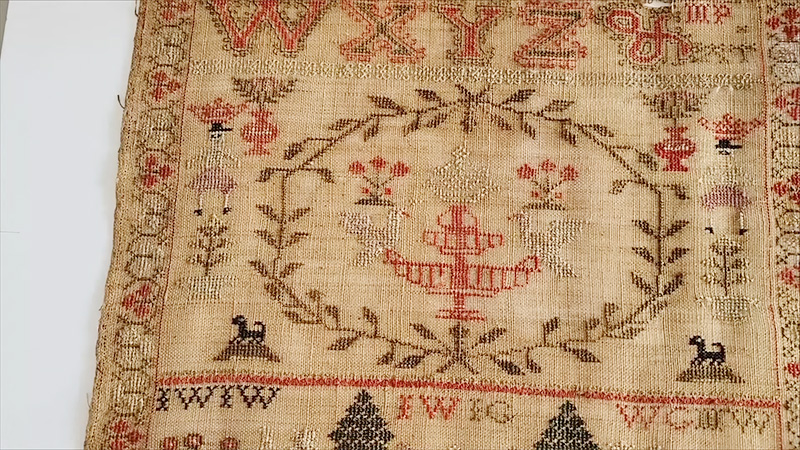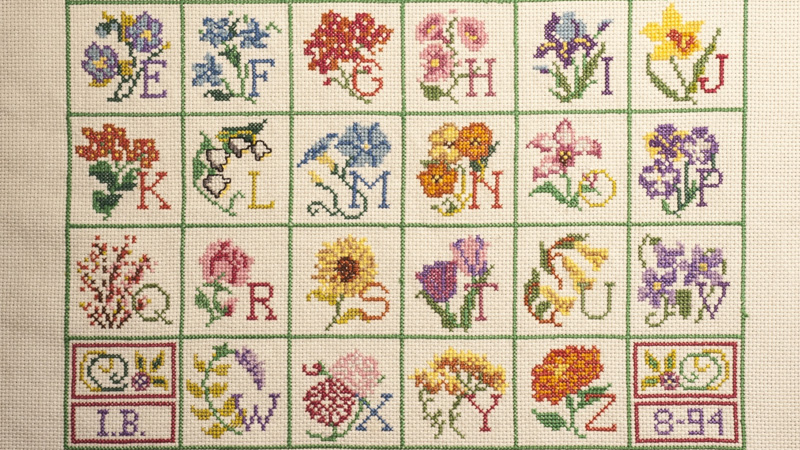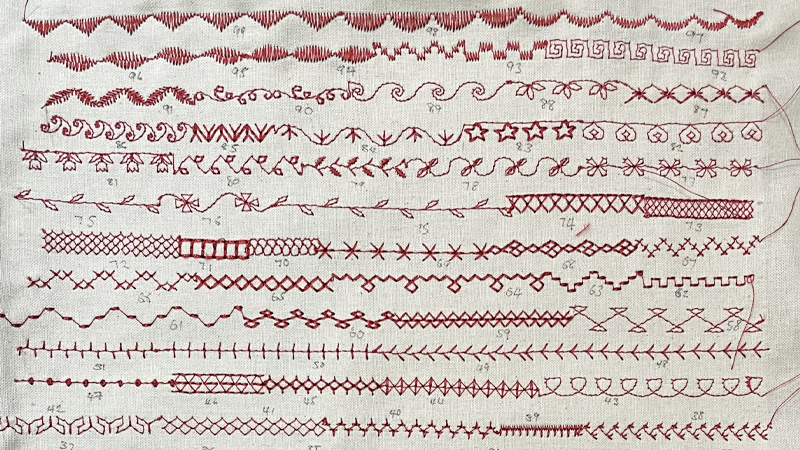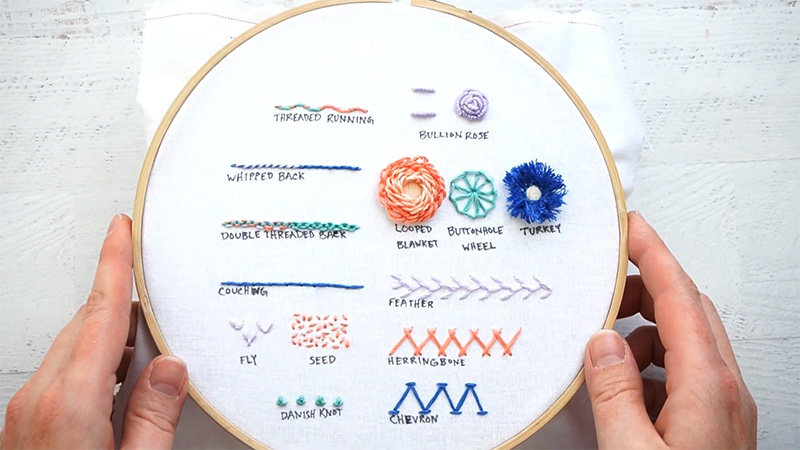In the realm of sewing and textile arts, the term “sampler” holds a significant place. A sampler in sewing is not just a piece of fabric but a canvas for creativity, skill development, and a rich tradition that spans centuries.
At its core, a sampler is a small practice piece where sewers and embroiderers experiment with various stitches, techniques, threads, and fabrics before embarking on more substantial projects.
These meticulously crafted miniatures are invaluable tools for beginners and seasoned artisans alike. They provide a controlled environment to refine sewing skills, explore new stitch patterns, and troubleshoot potential issues, ensuring that the main projects are executed with precision and confidence.
This introduction will delve into what is a sampler in sewing, shedding light on its historical significance, practical applications, and enduring appeal.

What Is A Sampler In Sewing?
A sampler in sewing refers to a small, practice piece of fabric that serves as a testing ground for various sewing techniques and stitches.
It is essentially a mini-project created by sewing enthusiasts, beginners, or professional seamstresses to hone their skills, experiment with different threads, needles, tensions, and fabrics, and troubleshoot potential issues before working on their main sewing projects.
Samplers typically include a variety of stitching patterns, such as straight stitches, zigzags, decorative stitches, buttonholes, and more.
They are valuable tools for mastering the art of sewing, as they allow individuals to gain confidence and familiarity with their sewing machines, ensure proper tension settings, and practice precise seam allowances, ultimately leading to more polished and successful sewing projects.
Additionally, samplers can also serve as beautiful keepsakes or decorative items, showcasing the maker’s craftsmanship and creativity.
Here’s the purpose of Samplers-
Skill Development
The primary purpose of a sampler in sewing is skill development. It provides a platform for beginners to practice fundamental sewing techniques and stitches.
By repeatedly sewing lines, curves, and corners, individuals can build their dexterity and gain confidence in using a sewing machine or working by hand.
Stitch Exploration
Samplers offer an opportunity to explore various types of stitches, both basic and decorative. Sewers can experiment with straight stitches, zigzags, satin stitches, and intricate embroidery stitches.
This exploration helps them understand the capabilities of their sewing machine and expands their creative possibilities.
Thread and Fabric Testing
Different threads and fabrics behave differently when sewn. Samplers allow sewers to test various thread types, thicknesses, and tensions, as well as different fabric materials.
This helps in selecting the right combination for specific sewing projects, ensuring durability and the desired aesthetic.
Tension Adjustment
Achieving the correct tension on a sewing machine is crucial for producing high-quality seams. Samplers serve as testing grounds for adjusting thread tension, allowing sewers to troubleshoot issues like loose or tight stitches, thread breakage, or fabric puckering.
Buttonhole Practice

Creating buttonholes can be a challenging task for sewers, especially beginners. Samplers often include sections dedicated to practicing different types of buttonholes, ensuring that they can confidently add functional closures to garments or projects.
Seam Allowance Practice
Consistent seam allowances are essential for well-fitted garments. Samplers help sewers practice sewing along a marked seam allowance, ensuring precision and accuracy when working on full-sized projects.
Pattern and Design Exploration
Advanced samplers may include sections for experimenting with pattern making, fabric manipulation, or creative design elements. This allows experienced sewers to push their creative boundaries and develop unique techniques.
Troubleshooting
When issues arise during sewing, such as thread tension problems, skipped stitches, or fabric puckering, samplers offer a controlled environment for troubleshooting and finding solutions. Sewers can identify problems and practice techniques to address them effectively.
Portfolio and Reference
Completed samplers can serve as valuable references and portfolio pieces. They showcase a sewer’s progression, skill level, and creativity, making them useful for personal growth and potential professional opportunities in the world of sewing and fashion design.
How Are Samplers Made?

Samplers have a rich history and have evolved over time, taking on various forms and purposes. Here are the different origins and methods of creating samplers:
Historical Embroidery Samplers
Traditional embroidery samplers have roots dating back to the Renaissance and were primarily made by young girls as part of their education. These samplers typically featured alphabets, numbers, and decorative motifs.
They were stitched onto plain linen or cotton fabric using a variety of embroidery stitches.
Quilt Block Samplers
Quilt block samplers emerged in the 19th century and are made by sewing together multiple fabric blocks, each showcasing a different quilting pattern or design. Quilters use these samplers to practice and perfect their quilting techniques.
Cross-Stitch Samplers
Cross-stitch samplers are a specialized type of embroidery sampler focusing exclusively on cross-stitching. They often include intricate designs, motifs, and lettering and are stitched onto even-weave fabric like Aida cloth.
Sewing Machine Practice Samplers
With the advent of sewing machines, practice samplers began to incorporate machine stitching. These samplers are typically made by sewing lines, curves, and shapes using different machine stitches and settings.
Sampler Kits
Many individuals use sampler kits available in craft stores or online. These kits come with pre-printed fabric and a selection of threads or yarns, along with instructions for creating a specific design or pattern. Sampler kits cater to both beginners and experienced crafters.
Modern Mixed-Media Samplers
Contemporary samplers often go beyond traditional embroidery or quilting. They can incorporate mixed media elements such as fabric collage, painting, beadwork, and more, creating unique and eclectic pieces of art.
Digital Embroidery Samplers
In the digital age, embroidery machines have become prevalent. Digital embroidery samplers involve creating and stitching out intricate designs using computerized embroidery machines, allowing for precise and intricate patterns.
Educational Samplers
Some samplers are created as educational tools. For instance, in the field of fashion design, students might assemble samplers to demonstrate various sewing techniques or fabric manipulation methods as part of their coursework.
Personalized DIY Samplers
Many crafters and sewing enthusiasts create personalized samplers based on their interests and goals. They choose the type of fabric, stitches, and designs they want to include, making these samplers a reflection of their individual creativity and skill development.
Samplers have a diverse range of origins and techniques, catering to various crafting traditions and skill levels.
Whether it’s traditional embroidery, quilting, modern mixed-media art, or digital embroidery, samplers continue to be valuable tools for skill development and creative expression.
How to do a Basic Stitch Sampler?

Creating a Basic Stitch Sampler is a fantastic way to practice and showcase a variety of fundamental hand embroidery stitches. Here are the simple methods to guide you through the process:
Gather Your Supplies
Begin by gathering your embroidery supplies, which typically include embroidery floss in various colors, an embroidery hoop, embroidery needles, and a piece of fabric. You can use plain cotton or linen fabric for your sampler.
Design Your Sampler
Decide on the stitches you want to include in your sampler. Common basic stitches include running stitch, backstitch, satin stitch, chain stitch, French knot, blanket stitch, and stem stitch. Plan the layout and spacing of each stitch on your fabric.
Prepare the Fabric
Place your chosen fabric in the embroidery hoop, ensuring it’s taut but not overly stretched. This makes it easier to work on and keeps the fabric from puckering.
Start with Running Stitch
Begin your sampler with the running stitch, one of the simplest stitches. Bring the needle up from the back of the fabric, make a straight stitch, and then take the needle down again, leaving equal spaces between stitches.
Progress to Other Stitches
Move on to the other stitches you’ve selected. For each stitch, thread your needle with the appropriate color of embroidery floss and follow step-by-step instructions or tutorials for that specific stitch.
Ensure that you maintain even tension and spacing.
Label and Annotate
As you complete each stitch, consider labeling them by embroidering the name of the stitch or numbering them. You can also include notes or annotations to indicate any challenges you faced or variations you tried.
Finish and Display
Once you’ve embroidered all the stitches in your sampler, carefully remove the fabric from the hoop and trim any excess fabric around the edges. You can frame your completed sampler for display or keep it as a reference for future embroidery projects.
By following these steps, you’ll create a Basic Stitch Sampler that not only hones your embroidery skills but also serves as a reference for future projects. It’s a creative and practical way to explore the world of hand embroidery and build your stitching repertoire.
FAQs
What is a sampler in sewing?
A sampler in sewing is a small piece of fabric used for practicing various sewing techniques and stitches. It allows sewers to refine their skills, experiment with different threads and fabrics, and troubleshoot issues before working on larger projects.
Why are samplers important in sewing?
Samplers are essential in sewing because they provide a controlled environment for skill development, stitch exploration, and troubleshooting.
They help sewers build confidence, understand their equipment, and ensure quality in their sewing projects.
What types of stitches are typically found on sewing samplers?
Sewing samplers often include basic stitches like running stitch, backstitch, satin stitch, chain stitch, French knot, and blanket stitch. Advanced samplers may incorporate more complex embroidery stitches and decorative techniques.
Can samplers be used for both hand sewing and machine sewing?
Yes, samplers can be used for both hand sewing and machine sewing. They serve as practice grounds for mastering techniques and stitches regardless of the sewing method being employed.
Are samplers only for beginners?
No, samplers are valuable tools for sewers of all levels. Beginners use them to build skills, while experienced sewers use samplers to explore new techniques and as references for mastering specific stitches or designs.
Conclusion
In the world of sewing, the sampler remains a timeless and cherished companion for all who wield a needle and thread. Its humble beginnings as an educational tool for young girls have evolved into a versatile and artistic medium for anyone passionate about the textile arts.
The sampler, with its diverse forms and purposes, continues to serve as a gateway to skill development, creativity, and the preservation of sewing traditions.
Through the centuries, the sampler has stitched together generations, bridging the past and the present. Whether it’s the intricate cross-stitch samplers of yesteryears or the modern mixed-media creations of today, these small fabric canvases continue to tell stories of patience, precision, and artistry.
As a testament to the enduring allure of sewing, the sampler embodies the timeless thread that weaves the rich tapestry of sewing history, connecting us to the artistry and craftsmanship of those who came before us while inspiring the creativity of generations yet to come.
Leave a Reply